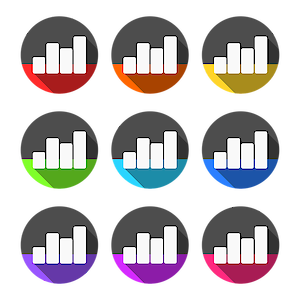Conversion Rate Optimisation (CRO)
What is it?
The general and most common definition of Conversion Rate Optimisation (CRO) is “the method of using analytics and user feedback to improve the performance of your website” (Qualaroo 2017). But that could mean many things, depending on organisation’s/website ultimate aim.
Successful conversion implies that a visitor to your website has taken the action you’ve intended them to take. This could mean virtually anything from creating an account, downloading an app, signing up for an email newsletter, making a purchase or something else.
In order to optimise conversion and make it happen more often and more easily, we need to look at what visitors are doing on our site, and whether their experience can be improved. CRO is simply “finding why visitors aren’t converting and fixing it” (Qualaroo 2017).
Apart from these general definitions, CRO is largely defined by your own organisation’s needs and wants. It is:
- “A structured and systematic approach to improving the performance of your site
- Informed by insights – specifically, analytics (software such as Google Analytics) and user feedback (surveys, quantitative, qualitative)
- Defined by your website’s unique objectives and needs (KPIs)
- Taking the traffic you already have and making the most of it” (Qualaroo 2017)
Analytics Metrics and Key Concepts Relevant to You and Your Customers
Analytics insights
Several insights are important in understanding a visitor's experience of your website.
- Bounce Rate – the actual percentage of people, who for whatever reason, leave your site after viewing a single page. This is an indicator that they might not be easily finding what they are looking for.
- Exit Rate – this relates to a specific page of your site and represents the percentage of people who leave your site after reaching that page. It might mean there is something inherently wrong with that page to make your visitors leave.
- Average Time on Site – self-explanatory, this metric provides you with a general view of how long people spend on your site – do they spend long enough to do what you want them to do?
- Average Page Views – your engagement metric, which informs you on how many pages the average visitor sees before leaving your site. A lot of pages viewed in a short time might indicate a lack of clarity, which might be frsutrating.
Key concepts
- The ‘conversion funnel’ – the basic path or ‘steps’ a visitor takes, from start to finish (beginning as a simple visitor and leaving as a converted customer, having done what you want them to do). For example, on e-commerce sites this could be - Home page --> Women’s Shoe catalogue --> (Chosen) Shoe product page --> Checkout.
- Call to Action (CTA) – this is the most important form of your website’s user interface (button, link etc) leading to and urging a user to complete the desired action you’ve planned for them – in other words, converting them. Buttons such as a “Buy now” button, “Download now” button, “Sign up today” button. Paramount here is using actionable language.
Why is CRO so important?
 To quote Qualaroo again, and bearing in mind the definitions we’ve made on CRO so far, there are quite a few reasons:
To quote Qualaroo again, and bearing in mind the definitions we’ve made on CRO so far, there are quite a few reasons:
- You can always improve your customer’s journey – regardless of your website’s CRO proficiency, chances are there is always some little detail you’ve overlooked and can optimise.
- Paid advertising is not always best – often, it's expensive and competitive. Rather, take what you already have and improve it. CRO helps you find the areas that need fixing for the smoothest customer journey.
- CRO gets you more of the right kind of customers – people who are looking for exactly what you're offering.
- CRO costs you nothing but maximises your profits – as it works with the audience you already have. Upping your game in converting those same people into active happy customers will increase your return on investment (ROI), which is directly reflected in your bottom line. No need to spend more money attracting more visitors to your site.
- Hence, increasing your conversion rate actually means halving the money you spend to get each new customer. So your cost-per-acquisition lowers.
- Therefore, you find yourself having more money to spend on further acquisition – and you know where to spend it, because you have insights on which part of your customer journey brings in the most traffic.
- Naturally, you yourself become more valuable to your stakeholders, being so effective.
- Capitalising on users’ low attention span - through CRO you provide your users with what they need – and do so FAST, before they go looking for it somewhere else.
- Enhanced CRO grants momentum – you rapidly increase your market share. The better you convert customers, the sooner you start being able to afford more traffic, thus more customers, and more of everything else!
How can we influence it? – CRO and Psychology
NB Communication recently took a webinar led by ClickThrough, and learned there are some big psychological factors which impact CRO.
 The way people behave on a website - and therefore, CRO - is linked to many of our subconscious psychological concepts: pleasure seeking, pain avoidance, loss aversion, novelty seeking (adrenaline and thrills), curiosity, uniting against a common enemy, choice paralysis, social proof, scarcity and urgency and the fear of missing out (FOMO).
The way people behave on a website - and therefore, CRO - is linked to many of our subconscious psychological concepts: pleasure seeking, pain avoidance, loss aversion, novelty seeking (adrenaline and thrills), curiosity, uniting against a common enemy, choice paralysis, social proof, scarcity and urgency and the fear of missing out (FOMO).
These concepts are linked to the two systems in operation in our brain – the automatic, which is fast and emotional (this operates our feelings and intentions), and the cognitive, which is slow and controlled (which operates our decisions and beliefs).
For optimum CRO we want customers to use the automatic parts of their brain, and, because the cognitive system kicks in under difficult situations, we don't want anything on our site that that would cause coginitive load (which would translate as negative feelings and therefore, no conversion).
How to Prevent Cognitive Load
To prevent this from happening we need to ensure the following customer journey checkpoints are as straightforward, easy, clear and painless as possible.
We need easy, seamless straightforward navigation.
Great visuals and engaging graphics which are also relevant, clear, unique and positioned well (as opposed to overwhelming and confusing).
Usability is paramount. After all, your users need to be able to find what they are looking for, and be able to do so fast. Your site needs to be responsive, uncluttered and user-friendly in every possible way.
Take a look at your security as well – today SSL certificates are something you simply need to have (have a look at our SSL Certificates blog post for further info). Otherwise you risk being disregarded as potentially harmful to your users (and you really don’t want that…!)
Your Search Engine Optimisation (SEO) is also very important and should always be relevant, utilising the proper key words and meta data. But essentially you should provide good, useful content. This will boost your SEO rating.
Load speed. Most of modern users are on their mobiles and most of them on their mobile networks – so make sure your services are available to them quickly, before they are bored or annoyed – deliver and be first to do it.
Make sure you always encourage regular customer feedback, ratings and testimonials – these are essential for good CRO.
Familiarity
One very simple way of preventing unnecessary cognitive load is familiarity: what we already know and have seen, we feel comfortable with – we quickly process, understand and work with.
Using a common design template might sound like a no-no interms of uniqueness, but implementing certain standards (such as scrolling) will make your customers feel comfortalke on your site.
Choice Paralysis
A red alert here for unnecessary cognitive load. Too much choice will generally confuse your customers and result in delayed reactions, high bounce and exit rates, general disorientation.
Subtlety and Ambiguity
Being unclear - either with an opverly complex general layout, or poor navigation - will most likely result in high bounce and exit rates and general disorientation.
Concise Web Copy
Short sentences, clear headings, easily understandable language and uncluttered pages are all essential.
Countering user anxiety and concerns
Make every effort to reassure your customers. This might be in terms of general customer support, or details on your product. If they need to fill in any forms make sure these are as short and as clear as possible.
Make sure the security you provide is clear and easy for your users to understand – use short and clear privacy statements, trust seals and payment processor logos, where relevant.
Persuasion Mechanisms
Further customer journey checkpoints...
- Reciprocity – initiate the exchange with your users yourself – start off with freebies.
- Consistency – in every sense. Continuous communication and support, brand image consistency, matching values with your target market.
- Social Proof – people are inclined to (at least) have a look at what you offer and give you a chance if someone’s recommended you – so make sure you get testimonials!
- Liking – build rapport and highlight how you counter common issues your users might have faced in the past – if you get them to like you, you are more likely to convert them.
- Authority – don’t miss a chance to highlight your professional expertise and intelligence.
- Scarcity/FOMO – Line such as “Two other people are looking at these just now. Decide quickly!” suggest higher value, imply countdowns and limited time and stock for making decisions.
 To conclude…
To conclude…
You should always test. Whatever you do – you need to know how much (if at all) it is helping you achieve your goal to convert as many visitors as possible. How well are the improvements you are making contributing towards your site’s overall performance in relation to CRO?
Some useful further reading on this would be:
- Qualaroo’s Coversion Rate Optimisation guide;
- PRWD’s How does conversion rate optimisation testing work?
- Econsultancy’s What is conversion rate optimization (CRO) and why do you need it?
NB’s digital marketing experts will gladly help you achieve your marketing goals online. Get in touch and we'll make every effort to ensure you achieve the results you want by improving every step of your customers' journey.
